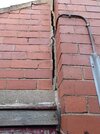We have a single story extension that has rotated. Structural engineer says movement stopped decades ago and it is worth trying to save the extension. We can't afford to pay for the work so I'm trying to scope the DIY job needed. It needs a floor and some new lintels over windows/doors but I've got one problem that I don't know where to start with.
The extension wasn't tied into the house and when it has rotated it has come away as per the photo. How do I tie these bricks into the main house wall, and how do I close that gap? Any ideas gratefully received.
The extension wasn't tied into the house and when it has rotated it has come away as per the photo. How do I tie these bricks into the main house wall, and how do I close that gap? Any ideas gratefully received.



